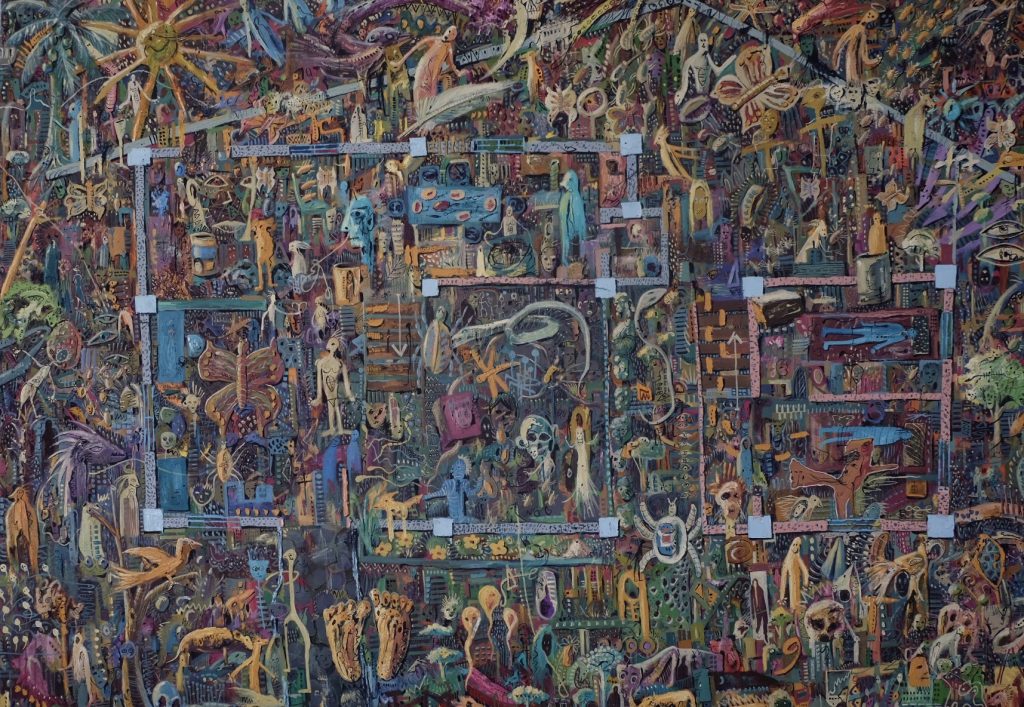DOROG
Paul John Cabanalan
January 13 - February 2, 2018

Homage to the Village:
“Dorog” by PJ Cabanalan
By Carlomar Arcangel Daoana
In his first one-man show opening at Art Verité on January 6, 2018, PJ Cabanalan pays homage to the village where everything began for the artist: Dorog in Leon, Iloilo, the name of which lends the title for this exhibition. Evoked through large-scale works, Dorog is an extension, expansion, and exploration of Cabanalan’s work, “Genesis,” which won the grand prize in the Metrobank Art and Design Excellence (MADE) for the Oil/Acrylic category last year. By plotting the works along the axis of place, Cabanalan affirms how geography is destiny in its ability to shape his “experiences, beliefs, tradition, and life story.”
In paintings that are lush with objects, symbols, and the artist’s personal metaphors—recalling the aesthetics of tapestry for their opulence, their narrative, and their revelations—geography is evidently rural, traversed with a national road (“Compound and Highway”), a river (“Source and Link”), and a farm (“Forest and Farm”) and populated with human structures designed for different purposes (“Worship and Praise,” “Learn and Play,” and “Love and Family”). Cabanalan, however, belies the cliché of the “sleepy countryside” by presenting to us spaces replete with activity, explosive with detail, and redolent with an otherworldly beauty.
The artist was able to do this by foregoing conventional perspective and depicting the places of his paintings with multi-faceted views: top, side, front, past through walls and other barriers. The resulting works bear a vision of a world where both the natural and the man-made share the same weight and urgency and that no object is too small and insignificant for the artist’s consideration. Everything, the exhibit affirms, has its own space in the larger design of creation—even the interior life of the artist that is manifested through an array of hybrids forms and shapes.
Certainly, these works are not a direct, literal transcription of Dorog and its surrounding environs but a metamorphosis (a butterfly is one of the artist’s recurring motifs) through an active form of re-imagination, so much so that what we see is not simply place but the intersection of geography and biography. This is most evident in the work, “Love and Family.” Set against a frenetic, pulsating landscape is a collection of lines of evoking a house (Cabanalan is an architect by profession) within which pieces of evidence of life are played: the layout of a family meal, totems of childhood, human figures lying in bed, arrows, footsteps. It’s hard not think that these details are not freighted with a deeply personal meaning and a desire for self-mythology.
Dorog is Cabanalan’s love letter to the one place he has known so well, where his life began and continues to flourish—his veritable “genesis.” With an unsentimental view, he offers us snippets of this place that is not merely a setting but a powerful presence that directs people’s lives and livelihood, shaping, mutating, and irrevocably transforming them in more ways than one. Through his works, the artist shapes this place in return, inflecting and nourishing it with his fertile, fecund, far-seeing vision.